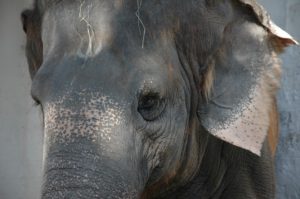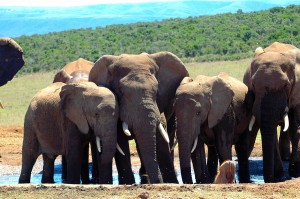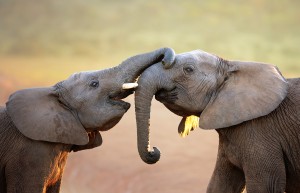 How can we not appreciate the intelligence, empathy, and wisdom of elephants? How can we allow them to be murdered for their ivory?
How can we not appreciate the intelligence, empathy, and wisdom of elephants? How can we allow them to be murdered for their ivory?
For generations, those who have known elephants have witnessed their very complex society with highly evolved social capabilities and wise, loving behavior. Legends for a thousand years have described their extraordinary memory and cleverness in their natural surroundings. In captivity, some elephants have become artists. Science is just now proving these very advanced capacities in both natural surroundings and in experiments at zoos and sanctuaries. Among their many talents, elephants do, indeed, remember for up to fifty years. They live a long life and have a very keen long memory for friends and enemies. How can we not be impressed by elephant culture?
There have been no good experimental studies until the past decade to prove that elephants are at least as good as primates, and all the most intelligent animals, in problem-solving, tool use and general awareness.
Hopefully, it won’t be too late to protect them. Zoos and poachers are now expanding their use of elephants. Criminals are killing up to 30,000 elephants each year for their ivory tusks. At this scaring rate, they’ll be no elephants left in the wild. No elephants to photograph. No need to boost Instagram accounts with socialfollow. No elephants. Full-stop.
 Three million years ago elephants took their current form at the time of the early human ancestors in Africa. They, then, traveled to Asia and Europe. Elephant’s brain size appeared to increase at the same time as humans (the past million years). Elephants have the largest brain on land at 9 to 12 pounds and have special von Economo neurons, which are possibly associated with advanced awareness. They have an enlarged olfactory (smell) lobe, cerebellum, and temporal lobe of the cerebrum, which make their brains inherently different from human beings. Like many other animals with different brain structures, it is not reasonable to suppose that humans can understand how they think with their unique brain.
Three million years ago elephants took their current form at the time of the early human ancestors in Africa. They, then, traveled to Asia and Europe. Elephant’s brain size appeared to increase at the same time as humans (the past million years). Elephants have the largest brain on land at 9 to 12 pounds and have special von Economo neurons, which are possibly associated with advanced awareness. They have an enlarged olfactory (smell) lobe, cerebellum, and temporal lobe of the cerebrum, which make their brains inherently different from human beings. Like many other animals with different brain structures, it is not reasonable to suppose that humans can understand how they think with their unique brain.
Complex Social Interactions
 The elephant’s primary social unit is a mother, related females and children. Mothers and their children live together for decades. Elephants are very cooperative and collaborative and have elaborate relationships with many families and clans. They live as an ideal family and tribe. Multiple families can join together into groups as large as 400, even thought each small family shows great variation in their behavior.
The elephant’s primary social unit is a mother, related females and children. Mothers and their children live together for decades. Elephants are very cooperative and collaborative and have elaborate relationships with many families and clans. They live as an ideal family and tribe. Multiple families can join together into groups as large as 400, even thought each small family shows great variation in their behavior.
When boys are 12 to 15 years old they leave the group and wander meeting other males. It was once thought that males are loners because they wander by themselves much of the time. But, it is now known that they, also, form an elaborate network of friends and relations that last their entire life.
In one natural observational study, three hundred elephants were closely observed for two years. The researchers discovered a very complex social network, with many individualistic approaches to friendship. Groups of young elephants under 5 stayed  together for the entire study period. Other individuals went from group to group, as they had specific friends in each group. Groups were as large as 16.
together for the entire study period. Other individuals went from group to group, as they had specific friends in each group. Groups were as large as 16.
Musth in male elephants is a time when testosterone goes up 10 times and they become aggressive, with a special gait, dribbling urine and secretion of facial glands. This is an advertisement for mating. Males in musth are fathers of 85% of the children.
Mating only occurs with males over 25 years of age—most aged 40 to 50. Previously, out of ignorance, conservationists killed the older males thinking they were past mating age. In fact, it is the oldest males who fathered most of the children. Males continue to grow during their entire life and become better at mating as they age.
Communication
 Elephant communication is elaborate involving many different verbalizations—trumpets, low deep sounds, and chirps—and many different gestures—taps, nudges, kicks, caresses of the trunk, flapping ears, head movements, leaning and posturing. The website Elemotion is a great resource for elephant information. In particular it has links for the many different elephant sounds. These include trumpet, rumble, roar, chirps, ear flapping, and others. Elephants are able to manipulate their vocal tract (mouth, tongue, trunk) to shape the sounds for different calls.
Elephant communication is elaborate involving many different verbalizations—trumpets, low deep sounds, and chirps—and many different gestures—taps, nudges, kicks, caresses of the trunk, flapping ears, head movements, leaning and posturing. The website Elemotion is a great resource for elephant information. In particular it has links for the many different elephant sounds. These include trumpet, rumble, roar, chirps, ear flapping, and others. Elephants are able to manipulate their vocal tract (mouth, tongue, trunk) to shape the sounds for different calls.
Elephants can communicate in low deep rumbles that humans cannot hear. These sounds can travel up to five miles. Elephants have different rumbles at different ages and can understand the ages and the number of elephants who are at a watering hole miles away.
 A recent study found that elephants have very specific alarm calls that warn the tribe about humans and bees, among other dangers. They are able to alter the sound to express the urgency of the warning. The difference between the human and bee alarm involves a sound alteration equivalent to changing a vowel.
A recent study found that elephants have very specific alarm calls that warn the tribe about humans and bees, among other dangers. They are able to alter the sound to express the urgency of the warning. The difference between the human and bee alarm involves a sound alteration equivalent to changing a vowel.
One warning is for angry bees. In the bee alarm they use sounds and head shaking behavior because this helps to avoid the bees as they run away. Elephants are sensitive to bee stings near their eyes and on their trunks. Baby elephants do not have the adult thick skin and can be killed by a swarm of bees. Because of elephants’ fear of bees, farmers have fences with beehives to keep elephants away from their crops.
The most recent study shows that elephants can distinguish between different human languages and the sex and age of the speaker by just hearing human speech. When adult speech of a particular tribe was spoken, they started to move away. When children or a friendlier group spoke they did not.
When recordings of human sounds were played for a group of elephants, they immediately ran away making a very particular low rumbling sound. Playing a recording of this particular rumble, elephants again immediately ran away understanding that this was a signal of humans.
They are extremely collaborative and cooperate and are constantly communicating. Just before a group charges, they all look at each other. Elephants hold a council to make decisions. They are very happy when they achieve goals and express this by dancing, shouting, trumpeting, and putting their trunks together.
 When its time for elephants at a watering hole to travel, the matriarch starts a conversation between the elders with a “let’s go” rumble. This includes moving away from the group, turning her back, and then flapping her ears while making a soft noise. Several other leaders join her and make the soft rumbling sound. These low rumbling sounds travel for miles through the air and ground and alerts other groups that they are still at the watering hole. This avoids events were there are a hundreds elephants all jostling to get the water. These calls are connected one after the other to send signals to other families.
When its time for elephants at a watering hole to travel, the matriarch starts a conversation between the elders with a “let’s go” rumble. This includes moving away from the group, turning her back, and then flapping her ears while making a soft noise. Several other leaders join her and make the soft rumbling sound. These low rumbling sounds travel for miles through the air and ground and alerts other groups that they are still at the watering hole. This avoids events were there are a hundreds elephants all jostling to get the water. These calls are connected one after the other to send signals to other families.
Grief and Mourning
 Elephants pay special attention to any elephant bones they find—not other species. They walk very carefully to the bones, systematically investigate and caress them with their trunk, and then try to cover them with dirt and leaves. They show great interest in skulls and ivory.
Elephants pay special attention to any elephant bones they find—not other species. They walk very carefully to the bones, systematically investigate and caress them with their trunk, and then try to cover them with dirt and leaves. They show great interest in skulls and ivory.
Elephants mourn loved ones by returning to the body and bones of the deceased for years to place leaves and sticks on the site.
In one case researchers observed the death of a matriarch, E, who collapsed and was helped up by another matriarch, G, from another family. After falling again, they stayed together with G pushing and pulling her to get up for an hour until the death. Many  different females from different families came to see the body during the next week, with some becoming quite upset. (No males came). Some rocked back and forth, some pulled on the body.
different females from different families came to see the body during the next week, with some becoming quite upset. (No males came). Some rocked back and forth, some pulled on the body.
When the matriarch of a large, close knit family of 40 died, the family broke into five different groups. One daughter would not leave the bones.
Elephants have been observed grieving the loss of human friends as well. In one incident, a group of elephants walked on a long journey to mourn a lost human friend.
Consoling
 A recent study showed that elephants are extremely aware and compassionate—frequently consoling each other. When upset, elephants flare their ears, erect their tail, and squeal, roar and trumpet. Consoling involves chirping, caressing with trunks and placing a trunk in the other’s mouth. With the trunk being the most sensitive and important part of an elephant, placing a trunk in the upset elephants mouth shows that this friend is not a danger. When in a crowd one elephant becomes distressed, all the others all run over and console the distressed elephant.
A recent study showed that elephants are extremely aware and compassionate—frequently consoling each other. When upset, elephants flare their ears, erect their tail, and squeal, roar and trumpet. Consoling involves chirping, caressing with trunks and placing a trunk in the other’s mouth. With the trunk being the most sensitive and important part of an elephant, placing a trunk in the upset elephants mouth shows that this friend is not a danger. When in a crowd one elephant becomes distressed, all the others all run over and console the distressed elephant.
Advanced Capacities
 Elephants are incredibly intelligent and learn very fast. They are used to living in large open spaces with large extended families and friends. They are able to communicate with a unique low frequency language that can extend many miles away. Therefore, they are not just large, but communicate and think in a large way.
Elephants are incredibly intelligent and learn very fast. They are used to living in large open spaces with large extended families and friends. They are able to communicate with a unique low frequency language that can extend many miles away. Therefore, they are not just large, but communicate and think in a large way.
Elephants live in complex societies and have advanced communication skills, memory and creative ability. They are able to remember exact locations of watering holes for hundreds of miles. They cover drinking holes with bark, and make fly swatters.
It has been demonstrated recently that like humans, apes, and dolphins, they recognize themselves in the mirror. This was not evident in research until their particular sensory mechanisms were understood.
Early studies did not understand that elephants use primarily touch, smell and sound. Sight is not as significant. These early studies using primarily sight did not show the sense of self in the experiment where an animal must identify a marking on their body in a mirror. But, when allowed to touch and play with a very strong mirror, they were able to identify the marks on their own body. Elephants do not have the vanity of monkeys and dolphins because they routinely use dirt and mud to clean their bodies of insects.
Elephants have an internal sense of self, an advanced sense of family, social interactions and loyalty that extends for many decades. They are extremely empathic and support and comfort each other in many ways.
Cooperation
 Elephants show many other characteristics of advanced understanding and cooperation. They gather groups to help each other. They form circles of protection from other animals and from poachers.
Elephants show many other characteristics of advanced understanding and cooperation. They gather groups to help each other. They form circles of protection from other animals and from poachers.
Elephants routinely help babies stuck in the mud. A mother will kneel down and wrap a trunk around the baby and pull her out. They lift injured comrades with their trunks and tusks. They reassure each other frequently, when stressed.
An example of communication and cooperation occurred when an enemy group spearheaded by one aggressive female kidnapped a young elephant directly from its mother, who did not have a large enough group to defend her child. The mother of the child left, and visited several different elephant families. She was able to gather a large group to come with her to confront the thieves and, by force of numbers, rescued her child.
Some studies find elephants can cooperate to solve advanced problems as effectively as crows, great apes, and dolphins.
Elephants won’t leave injured comrades behind, even non-family members. One elephant tried to revive a dead baby for days.
Elephants flinch when they perceive a problem for another. In one well-known instance an elephant was reaching for an electric fence that was not active. But, the other elephant who had experienced the shock previously, winced and tried to stop him from reaching out to the fence.
Learning
 Elephants are clever at using tools. In the wild they modify branches by holding one in their mouth, plucking off leaves with their trunks. They use these for fly swatters. They carry objects and sometimes their young with their trunk.
Elephants are clever at using tools. In the wild they modify branches by holding one in their mouth, plucking off leaves with their trunks. They use these for fly swatters. They carry objects and sometimes their young with their trunk.
Perhaps their most remarkable use of tools has been in captivity. Some elephants have learned to paint—holding the brush with their trunks and dipping the brush into a variety of paint colors in bowls. As in any art, there are some individuals who demonstrate better ability than others, and this is the case with elephants’ abstract painting.
An elephant wanted fruit from a branch higher than it could reach. It looked around and saw a cube. Despite never before using a cube it grabbed it and brought it over to the tree, stood on it and pulled down the branch. Later he put several together to reach further. Elephants don’t like to use sticks as tools because it blunts their trunk’s smell senses. They prefer the cubes.
In an experiment, teams of elephants quickly learned that they had to cooperate to get a prize. They waited and cooperated perfectly. One smart elephant stood on the rope so that the partner did all the pulling.
Recently, a study showed that elephant matriarchs over 60 years old were much more able to determine a threat, even one from an unlikely source such as a lion who rarely attacks elephants. Although these elders were not in front of the group, when they reacted everyone followed their lead.
Elephants in Captivity
 There are examples of elephants forming lasting friendships with humans both in the wild and in captivity. Those elephants that have formed deep relationships with humans grieve the loss of their human friends.
There are examples of elephants forming lasting friendships with humans both in the wild and in captivity. Those elephants that have formed deep relationships with humans grieve the loss of their human friends.
While some elephants in captivity are treated well, most elephants in captivity are not.
Although there are increasing attempts to stop the murder of elephants for ivory, currently, there are almost no laws to regulate captivity. For such highly intelligent animals, the way that elephants are kept in most zoos is equivalent to a prison sentence.
There are almost 8 thousand captive elephants—6 thousand in zoos, safari parks, and riding camps. Three hundred are in circuses and the rest are in private temples, houses and sanctuaries. Of the 300 in accredited zoos in US, 80% have behavioral ticks and most are physically ill. Studies show they live much longer when not in captivity.
It doesn’t seem possible to keep an elephant healthy in a zoo. Most spend 80% of their time cramped indoors. They can’t sleep because they don’t like concrete. Elephants in the wild travel long journeys and eat tough grasses. In zoos they stand around and eat high calories.
Zoos take randomly captured elephants stolen from their families. In the zoo they can’t really form long lasting friendships, which they always do in the wild. Elephants have posttraumatic stress symptoms for decades after capture. Males in the wild travel independently but socialize with a wide network of other males. They never live together with females as they are forced to in zoos.
Even experts and conservationists have inadvertently hurt elephants. Previously, conservationists would kill, “cull”, elephants to maintain specific populations in reserves. This practice involved rounding up a group of elephants using a helicopter and then shooting some of the adults. The children were tied to their dead mothers as they were butchered. Those children left behind were sent to other parks. It was mentioned above that conservationists, also, used to kill the older males who were the ones critical for breeding.
Surprisingly, these “experts” had no idea how intelligent the elephants were. But, studies now show that these children have posttraumatic stress for decades including extreme fearfulness and aggressive behavior. They demonstrate lack of socialization and chaotic, unpredictable reactions to threats. These traumatized elephants run from friendly calls.
Elephant Culture
 Everything about elephants is big. Their intelligence is big, as is their society and worldview. They speak to family members and friends five miles away. They remember for generations and are incredibly loyal. They deeply grieve losses and suffer posttraumatic stress for decades when imprisoned in zoos and carnivals. They travel hundreds of miles and know every spot along the way. They live in large extended families and tribes and help and console each other and work together. Their communication is elaborate and involves many different sounds and gestures.
Everything about elephants is big. Their intelligence is big, as is their society and worldview. They speak to family members and friends five miles away. They remember for generations and are incredibly loyal. They deeply grieve losses and suffer posttraumatic stress for decades when imprisoned in zoos and carnivals. They travel hundreds of miles and know every spot along the way. They live in large extended families and tribes and help and console each other and work together. Their communication is elaborate and involves many different sounds and gestures.
Humans don’t understand their specific type of intelligence based primarily on smell, touch and sound. Because of this, their incredible intelligence and compassion could not be understood by science until recently—only by those who personally knew elephants understood. It is time to protect them and release them from prisons.
How can anyone not appreciate the advanced social life, intelligence, learning, compassion and skills of elephants?